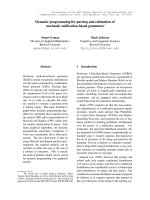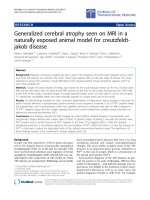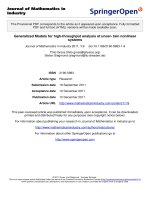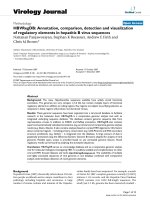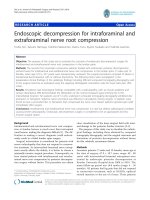Báo cáo hóa học: " Generalized conditions for starlikeness and convexity of certain analytic functions" doc
Bạn đang xem bản rút gọn của tài liệu. Xem và tải ngay bản đầy đủ của tài liệu tại đây (223 KB, 6 trang )
RESEARCH Open Access
Generalized conditions for starlikeness and
convexity of certain analytic functions
Neslihan Uyanik
1
and Shigeyoshi Owa
2*
* Correspondence: owa@math.
kindai.ac.jp
2
Department of Mathematics, Kinki
University, Higashi-Osaka, Osaka
577-8502, Japan
Full list of author information is
available at the end of the article
Abstract
For analytic functions f(z) in the open unit disk
U
with f (0) = 0 and f ’(0) = 1,
Nunokawa et al. (Turk J Math 34, 333-337, 2010)have shown some conditions for
starlikeness and convexity of f(z). The object of the present paper is to derive some
generalized conditions for starlikeness and convexity of functions f(z) with examples.
2010 Mathematics Subject Classification: Primary 30C45.
Keywords: Analytic function, starlike function, convex function
1 Introduction
Let
A
denote the class of functions f(z) of the form
f (z)=z +
∞
n
=2
a
n
z
n
(1:1)
which are analytic in the open unit disk
U =
{
z ∈ C:
|
z
|
< 1
}
.Let
S
be the subclass of
A
consisting of functions f(z) which are univalent in
U
.Afunction
f
(
z
)
∈
S
is said to
be starlike with respect to the origin in
U
if
f
(
U
)
is the starlike domain. We denote by
S
∗
the class of all starlike functions f(z) with respect to the origin in
U
. Furthermore, if
afunction
f
(
z
)
∈
S
satisfies
z
f
(
z
)
∈ S
∗
,thenf(z )issaidtobeconvexin
U
.Wealso
denote by
K
the class of all convex functions in
U
. Note that
K
⊂
S
∗
⊂
S
⊂ A
.
To discuss the univalency of
f
(
z
)
∈
A
, Nunokawa [1] has given
Lemma 1.1 If
f
(
z
)
∈
A
satisfies
f
(z)
< 1
(
z ∈ U
)
, then
f
(
z
)
∈
S
. Also, Mocanu [2]
has shown that
Lemma 1.2 If
f
(
z
)
∈
A
satisfies
|f
(z) −1| <
2
√
5
(z ∈
U)
,
then
f
(
z
)
∈ S
∗
.
In view of Lemmas 1.1 and 1.2, Nunokawa et al. [3] have proved the following
results.
Lemma 1.3 If
f
(
z
)
∈
A
satisfies
|f
(z)|
2
√
5
= 0.8944 (z ∈
U)
,
(1:2)
Then
f
(
z
)
∈ S
∗
.
Uyanik and Owa Journal of Inequalities and Applications 2011, 2011:87
/>© 2011 Uyanik and Owa; licensee Springer. This is an Open Access article distributed under the terms of the Creative Commons
Attribution License ( which permits unrestricted use, distribution, and reproduction in
any medium, provided the original work is properly cited.
Lemma 1.4 If
f
(
z
)
∈
A
satisfies
|
f
(z)|
1
√
5
= 0.4472 |(z ∈
U)
,
(1:3)
then
f
(
z
)
∈
K
.
The object of the present paper is to consider some generalized co nditions for func-
tions f(z) to be in the classes
S
∗
or
K
.
2 Generalized conditions for starlikeness
We begin with the statement and the proof of generalized conditions for starlikeness.
Theorem 2.1 If
f
(
z
)
∈
A
satisfies
|f
(j)
(z)|
2
√
5
− M (z ∈
U)
,
(2:1)
for some j(j = 2, 3, 4, ), then
f
(
z
)
∈ S
∗
, where
M =
⎧
⎨
⎩
0(j =2)
j−1
n
=2
|f
(n)
(0)| (j 3)
.
(2:2)
Proof For j = 2, the inequality (2.1) becomes (1.2) of Lemma 1.2. Thus, the theorem
is hold true for j = 2. We need to prove the inequality for j ≧ 3. Note that
f
(z)=
z
0
f
(t ) dt + f
(0)
.
(2:3)
We suppose that
|f
(
z
)
| N
3
(
z ∈ U
).
Then, (2.3) gives us that
|
f
(z)|
|z|
0
|f
(ρe
iθ
)dρ| + |f
(0)
|
N
3
|z| + |f
(0)|
< N
3
+ |f
(
0
)
|.
(2:4)
Therefore, if f(z) satisfies
|
f
(z)| < N
3
+ |f
(0)|
2
√
5
(
z ∈
U
)
,
(2:5)
then
f
(
z
)
∈ S
∗
by Lemma 1.3. This means that if f(z) satisfies
|f
(z)| N
3
2
√
5
−|f
(0)| (z ∈ U)
,
(2:6)
then
f
(
z
)
∈ S
∗
. Thus, the theorem is holds true for j =3.
Next, we suppose that the theorem is true for j =2,3,4, ,(k - 1). Then, letting
|f
(k)
(
z
)
| N
k
(
z ∈ U
),
we have that
Uyanik and Owa Journal of Inequalities and Applications 2011, 2011:87
/>Page 2 of 6
|
f
(k−1)
(z)| =
z
0
f
(k)
(t )dt + f
(k−1)
(0)
N
k
|z| + |f
(k−1)
(0)|
< N
k
+ |f
(k−1)
(
0
)
|.
(2:7)
Thus, if f(z) satisfies
|
f
(k
−1
)
(z)| < N
k
+ |f
(k
−1
)
(0)|
2
√
5
−
k−2
n
=2
|f
(n)
(0)|
,
(2:8)
then
f
(
z
)
∈ S
∗
. This is equivalent to
|
f
(k)
(z)| N
k
2
√
5
−
k
−1
n
=2
|f
(n)
(0)|
.
(2:9)
Therefore, the theorem holds true for j = k. Thus, applying the mathem atical induc-
tion, we complete the proof of the theorem.
Example 2.1 Let us consider a function
f
(
z
)
= z + a
2
z
2
+ a
3
z
3
+ a
4
z
4
.
(2:10)
Since
|
f
(
z
)
| =24|a
4
|,
if f(z) satisfies
24|a
4
|
2
√
5
− 2|a
2
|−6|a
3
|
,
then
f
(
z
)
∈ S
∗
. This is equivalent to
√
5
|
a
2
|
+3
√
5
|
a
3
|
+12
√
5
|
a
4
|
1
.
Therefore, we put
a
2
=
e
iθ
1
2
√
5
, a
3
=
e
iθ
2
9
√
5
, a
4
=
e
iθ
3
72
√
5
.
Consequently, we see that the function
f (z)=z +
e
iθ
1
2
√
5
z
2
+
e
iθ
2
9
√
5
z
3
+
e
iθ
3
72
√
5
z
4
is in the class
S
∗
.
3 Generalized conditions for convexity
For the convexity of f(z), we derive
Theorem 3.1 If
f
(
z
)
∈
A
satisfies
|
f
(j)
(z)|
1
j!
4
√
5
− P
(z ∈
U)
.
(3:1)
Uyanik and Owa Journal of Inequalities and Applications 2011, 2011:87
/>Page 3 of 6
for some j(j = 3, 4, 5, ), then
f
(
z
)
∈
K
, where
P =
j−1
n
=2
n ·n!|f
(n)
(0)|
.
(3:2)
Proof We have to prove for j ≧ 3. Note that
(zf
(z))
=2f
(z)+zf
(z)=2
⎛
⎝
z
0
f
(t )dt + f
(0)
⎞
⎠
+ zf
(z)
.
(3:3)
If
|f
(
z
)
| N
3
(
z ∈ U
),
then we have that
|
(zf
(z))
| 2
z
0
f
(t )dt + f
(0)
+ |zf
(z)|
2
|
z
|
0
|f
(ρe
iθ
)dρ| +2|f
(0)| + N
3
|z
|
3N
3
|z| +2|f
(0)|
< 3N
3
+2|f
(
0
)
|.
(3:4)
We know that
f
(
z
)
∈
K
if and only if
z
f
(
z
)
∈ S
∗
. Therefore, if
3N
3
+2
f
(0)
2
√
5
,
(3:5)
then
z
f
(
z
)
∈ S
∗
by means of Lemma 1.3. Thus, if
|
f
(z)| N
3
2
3
1
√
5
−|f
(0)|
(z ∈ U),
(3:6)
then
f
(
z
)
∈
K
. This shows that the theorem is true for j =3.
Next, we assume t hat theorem is true for j =3,4,5, ,(k - 1). Then, letting
|f
(k)
(
z
)
| N
k
(
z ∈ U
),
we obtain that
(zf
(z))
(k−1)
= |(k −1)f
(k−1)
(z)+zf
(k)
(z)|
=
(k −1)
⎛
⎝
z
0
f
(k)
(t )dt + f
(k−1)
(0)
⎞
⎠
+ zf
(k)
(z)
(k − 1)
⎛
⎝
|z|
0
|f
(k)
(ρe
iθ
)dρ| + |f
(k−1)
(0)|
⎞
⎠
+ |z|
f
(k)
(z)
.
(3:7)
Now, we consider
|f
(k)
(
z
)
| N
k
(
z ∈ U
),
. Then, (3.7) implies that
(zf
(z))
(k−1)
kN
k
|z| +(k −1)
f
(k−1)
(0)
< kN
k
+(k −1)
f
(k−1)
(0)
.
(3:8)
Uyanik and Owa Journal of Inequalities and Applications 2011, 2011:87
/>Page 4 of 6
Since, if
zf
(z)
(k−1)
1
(k −1)!
4
√
5
−
k−2
n=2
n ·n!
f
(n)
(0)
,
then
f
(
z
)
∈
K
(or
z
f
(
z
)
∈ S
∗
), if f(z) satisfies that
kN
k
+(k −1)
f
(k−1)
(0)
1
(k −1)!
4
√
5
−
k−2
n=2
n ·n!
f
(n)
(0)
,
(3:9)
that is, that
N
k
1
k!
4
√
5
−
k
−1
n=2
n ·n!
f
(n)
(0)
,
(3:10)
then
f
(
z
)
∈
K
.Thus,theresultistrueforj = k. Using the mathematical induction,
we complete the proof the theorem.
Example 3.1 We consider the function
f
(
z
)
= z + a
2
z
2
+ a
3
z
3
+ a
4
z
4
.
Then, if f(z) satisfies
24|a
4
|
1
24
4
√
5
− 8|a
2
|−108|a
3
|
,
then
f
(
z
)
∈
K
. Since
2
√
5
|
a
2
|
+27
√
5
|
a
3
|
+ 144
√
5
|
a
4
|
1
,
we consider
a
2
=
e
iθ
1
4
√
5
, a
3
=
e
iθ
2
81
√
5
, a
4
=
e
iθ
3
864
√
5
.
With this conditions, the function
f (z)=z +
e
iθ
1
4
√
5
z
2
+
e
iθ
2
81
√
5
z
3
+
e
iθ
3
864
√
5
z
4
belongs to the class
K
.
If we use the same technique as in the proof of Theorem 2.1 applying Lemma 1.4,
then we have
Theorem 3.2 If
f
(
z
)
∈
A
satisfies
|
f
(j)
(z)|
1
√
5
− M (z ∈
U
)
(3:11)
for some j (j = 2, 3, 4, ), then
f
(
z
)
∈
K
, where M is given by (2.2).
Acknowledgements
This paper was completed when the first author was visiting Department of Mathematics, Kinki University, Higashi-
Osaka, Osaka 577-8502, Japan, from Atat ürk University, Turkey, between February 17 and 26, 2011.
Uyanik and Owa Journal of Inequalities and Applications 2011, 2011:87
/>Page 5 of 6
Author details
1
Department of Mathematics, Kazim Karabekir Faculty of Education, Atatürk University, 25240 Erzurum, Turkey
2
Department of Mathematics, Kinki University, Higashi-Osaka, Osaka 577-8502, Japan
Received: 4 June 2011 Accepted: 17 October 2011 Published: 17 October 2011
References
1. Nunokawa, M: On the order of strongly starlikeness of strongly convex functions. Proc Jpn Acad. 68, 234–237 (1993)
2. Mocanu, PT: Some starlikeness conditions for analytic function. Rev Roum Math Pures Appl. 33, 117–124 (1988)
3. Nunokawa, M, Owa, S, Polatoglu, Y, Caglar, M, Duman, EY: Some sufficient conditions for starlikeness and convexity.
Turk J Math. 34, 333–337 (2010)
doi:10.1186/1029-242X-2011-87
Cite this article as: Uyanik and Owa: Generalized conditions for starlikeness and convexity of certain analytic
functions. Journal of Inequalities and Applications 2011 2011:87.
Submit your manuscript to a
journal and benefi t from:
7 Convenient online submission
7 Rigorous peer review
7 Immediate publication on acceptance
7 Open access: articles freely available online
7 High visibility within the fi eld
7 Retaining the copyright to your article
Submit your next manuscript at 7 springeropen.com
Uyanik and Owa Journal of Inequalities and Applications 2011, 2011:87
/>Page 6 of 6
